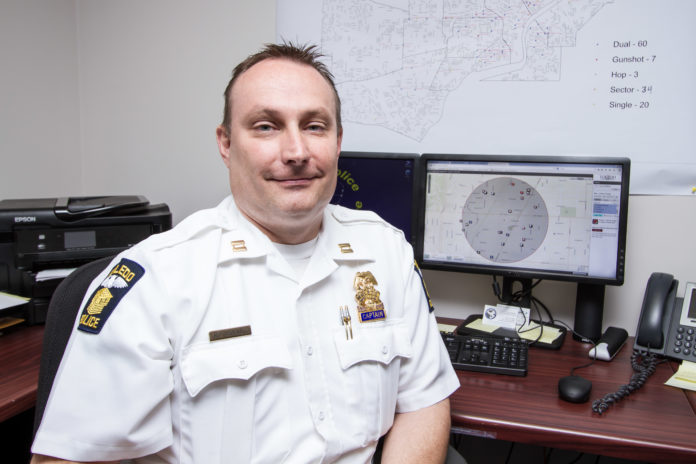
Gone are the days of filing cabinets stuffed with overlooked incident reports and other troves of underutilized data. For the past several years, police departments across the nation, including Toledo Police Department (TPD), have been transitioning to an “intelligence-led” model of crime-fighting, utilizing tools like interactive crime mapping and digital data-crunching to track trends, analyze statistics and make more effective use of department resources.
TPD has used online crime mapping internally since 2012. Now much of that same data is at the fingertips of area residents through a public version of the department’s interactive map, which launched May 15 at crimemap.toledo.oh.gov.

To access the map, users enter an address and from there can browse nearly all crimes reported within a half-mile radius within the past two months. Users can also sign up for email alerts and submit anonymous tips. The map is refreshed three times a day, at 6 a.m., 2 p.m. and 10 p.m. shift changes.
“What we’re trying to do is allow the public to see what’s happening in their neighborhood or their business area so they can be more informed,” said Capt. Mike Troendle, a 20-year TPD veteran who heads the department’s strategic response bureau.
“We cannot be in every neighborhood at the same time and, even if we’re in that neighborhood, we don’t always know what’s normal and what’s not, so having an active, involved citizenry is the best way for us to police. There is no question about that. By getting this out to them, we’re educating them more and in turn we’re helping ourselves.”
The map is also expected to reduce the time TPD spends handling public information requests, Troendle said.
“This allows people to go out there and basically do a self-service on it, freeing up my analysts to actually analyze more of the crime for our internal purposes and hopefully solve more crime,” he said.
The public map cost $6,200 through Dayton-based Optica Consulting, the same company that developed the department’s internal mapping system. Work on the public map started in October.
Public access to the data has always been the end goal, Troendle said.
“One of the things we wanted to do was satisfy our needs internally first, making sure our commanders and our officers were getting the information they need and setting it up the way they want it, and then it was the natural progression to go public,” he said.
Crime reports are listed by block, not exact address. Data for rapes, sexual assaults and juvenile-specific crimes such as curfew violations are excluded for privacy reasons, Troendle said.
TPD doesn’t differentiate between tips left through the map and tips left via TPD’s website, but Troendle said he knows people have used the map when leaving tips because some have referenced map data. The number of people who have signed up for email alerts was not immediately available.
One disappointment for some users is the map uses Flash, so it cannot be accessed on most tablets or smartphones. Troendle said that may change in the future.
“The company we work with is in development of an app, but we didn’t want to wait for that to come out,” Troendle said. “We wanted to get the information out there. We figured providing some sort of information for the public is better than not giving them any information at all.”
Data-driven
Former TPD Chief Derrick Diggs implemented the intelligence-led policing model when he became chief in late 2011, the most obvious change being the installation of surveillance cameras — although that’s only a small piece of the overall strategy, Troendle said.
“We collect data from every kind of source out there, from the mundane crime reports to social media. We take everything we can get intelligence-wise and we analyze that,” Troendle said. “Basically what we’re doing is putting our people where they need to be based on what the data is telling us.”
Since the shift, TPD has reduced its burglary rate by at least 30 percent, Troendle said.
That’s because a small percentage of people are responsible for a majority of the crime, he said, citing research from Temple University criminology professor Jerry Ratcliffe, an expert in intelligence-led policing and crime mapping, who concluded about 6 percent of the population is responsible for 60 percent of crime.
“It’s about working smarter, not just harder,” Ratcliffe told Florida’s Sarasota Herald-Tribune in 2011. “It’s about focusing resources. In the end, there are only so many police officers.”
Heather Buford, who along with her husband Cory are citywide co-chairs for Toledo Neighborhood Block Watch, said she’s excited as the map means members will now have access to statistics udaily as opposed to once a week from The Blade or once a month from TPD at block watch meetings.
“We love it. We think it’s great. With block watch being the eyes and the ears of the neighborhoods, it’s very helpful,” Heather said. “My husband and I have been pushing for something interactive for residents for years.
“I’m also thinking this will be a great way to get the younger generation involved,” Heather said. “If they could go on iPhones and iPads that would be even better.”
Other cities
Toledo is the last of Ohio’s four largest cities to launch an interactive public map of crime data. Thirty-one police departments in Ohio, including Akron, Columbus, Cincinnati, Waterville and Youngstown, use a free online mapping service called RAIDS (Regional Analysis and Information Sharing) Online. Crime information is updated daily and email alerts are available.
Cleveland Police Department (CPD) uses mapping technology developed by the City of Cleveland that integrates crime statistics into other city informational maps such as permits, licenses, capital projects, bikeways and land status, said CPD crime analyst Todd Wiles. Crime information is updated daily, but email alerts are not available.
Dayton Police Department uses technology nearly identical to Toledo’s as its map was also developed by Optica. TPD already had a relationship with Optica, which had developed its internal technology, so it made sense to stick with the company for the public site, Troendle said.
“For us to go with RAIDS Online, we would have to set up all kinds of new rules and processes to give them the data,” Troendle said. “With Optica those rules and processes were already in place, and it was just a matter of us creating a public-facing website to display the data. It was a much easier process to do it this way.”
Sgt. Eric Paull, who heads Akron Police Department’s (APD) crime analysis intelligence unit, met Troendle through the Northern Ohio Violent Crime Consortium (NOVCC), which also includes Akron, Toledo, Canton, Cleveland, Elyria, Lorain, Mansfield and Youngstown, as well as county, state and federal agencies.
Advantages to RAIDS are that it’s free and it’s a national system, incorporating data from more than 40 states, Washington, D.C., and two Canadian provinces, Paull said.
Disadvantages include that it’s not able to be customized, he said. For example, what APD would call breaking and entering is classified in the RAIDS software as “burglary commercial.”
“For free, [RAIDS is] the best thing that’s out there. But if you build something like Toledo [did], you’re going to get more functionality and a better system,” Paull said. “What Mike was able to do is much more customized. Those guys came in there and built that just for Toledo.”
Game changer
Such technology has revolutionized law enforcement, Paull said, recalling a serial rape case that required a detective to manually page through hundreds of old files looking for information.
“What he did in weeks we can now do in 10 minutes,” Paull said. “It makes a police department a ton more effective.”
Paull also recalled a serial burglar who was caught after data analysis revealed the day and time of day he typically struck.
“We could never do that kind of stuff before. It just wasn’t possible. We didn’t have the data,” Paull said.
However, technology doesn’t replace police work, Paull said.
“You can’t replace crime analysis with that. I’ve still got four full-time crime analysts,” he said.
But officers have faster access to information that is more up-to-date and more useful than in the past, said TPD Public Information Officer Sgt. Joe Heffernan.
“The information given to the commanders of where to direct their resources is so much better and that’s been really the main driver at reducing our crime in my opinion,” Heffernan said.
Geographical context
Esri, an international supplier of geographic information system (GIS) software, powers Toledo’s map developed by Optica.
“We add the geographical context to any type of intelligence,” said Communications Manager Brian Peterson. “Police departments were an early adapter of the technology.”
The main goal is crime prevention, said Mike King, Esri’s national law enforcement manager, who retired as a Utah police chief after a 30-year career in law enforcement.
“Anyone can throw a dot on a map and say a burglary happened here,” King said. “Esri not only puts the dot on the map, but helps explain why this dot is important to all the other dots. The real secret is the analysis behind the scenes. What can we do to forecast where events are going to happen based on history?
“Ten years ago, crime analysts would walk into a chief’s office with 50 sheets of paper, all the burglaries that month, sheets and sheets of data in tabular form. But if you can give someone the ability to visualize, people can understand that tabular data much more quickly.”
Giving the public access to crime data also helps create a partnership between police departments and the public.
“That’s the large and long-term goal, to form those partnerships so police have thousands of sets of eyes on the street,” King said.
Heffernan agreed.
“They always say, ‘Knowledge is power,’” Heffernan said. “This just enables us to do our job better and we can do our job even better when the public can assist us.”






















